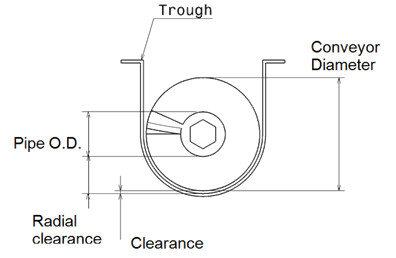Maximum lump size
Limitation in a screw conveyor
The maximum lump size is important. The size of a screw conveyor not only depends on the capacity required, but also on the size and proportion of lumps in the material to be handled. The size of a lump is the maximum dimension it has. A closer definition of the lump size would be the diameter of a ring through which the lump would pass. However, if a lump has one dimension much longer than its transverse cross-section, the long dimension or length would determine the lump size. The character of the lump also is involved. Some materials have hard lumps that won’t break up in transit through a screw conveyor. In that case provision must be made to handle these lumps. Other materials may have lumps that are fairly hard, but degradable in transit through the screw conveyor, thus really reducing the lump size to be handled. Still other materials have lumps that are easily broken in a screw conveyor and lumps of these materials impose no limitations.

Class 1
A mixture of lumps and fines in which not more than 10% are lumps ranging from maximum size to one half of the maximum; and 90% are lumps smaller than one half of the maximum size.

Class 2
A mixture of lumps and fines in which not more than 25% are lumps ranging from the maximum size to one half of the maximum; and 75% are lumps smaller than one half of the maximum size.

Class 3
A mixture of lumps only in which 95% or more are lumps ranging from maximum size to one half of the maximum size; and 5% or less are lumps less than one tenth of the maximum size.
A mixture of lumps only in which 95% or more are lumps ranging from maximum size to one half of the maximum size; and 5% or less are lumps less than one tenth of the maximum size.
The Maximum lump size table shows the recommended maximum lump size for each customary screw diameter and the three lump classes. The ratio, R, is included to show the average factor used for the normal screw diameters which then may be used as a guide for special screw sizes and constructions. The allowable size of a lump in a screw conveyor is a function of the radial clearance between the outside diameter of the central pipe and the radius of the inside of the screw trough, as well as the proportion of lumps in the mix. The following illustration illustrates this relationship.
Table in mm
The Maximum lump size table with R=Radial clearance(mm)/Lump size (mm)

| Diamètre de vis (mm) | Diamètre de l'âme | Jeu radial (mm) | Classe 1 | Classe 2 | Classe 3 |
|---|---|---|---|---|---|
| 50.8 | 24 | 13 | 6 | 3.8 | 2.5 |
| 76.2 | 30 | 25 | 13 | 6 | 2.5 |
| 101.6 | 39 | 33 | 17 | 13 | 6 |
| 150 | 57 | 49 | 31 | 19 | 13 |
| 228.6 | 57 | 86 | 57 | 38 | 19 |
| 304.8 | 60 | 122 | 70 | 50 | 25 |
| 356 | 140 | 103 | 82 | 63 | 32 |
| 406 | 140 | 138 | 95 | 70 | 38 |
| 508 | 180 | 194 | 108 | 76 | 45 |
| 557 | 180 | 170 | 120 | 89 | 50 |
| 609 | 225 | 197 | 152 | 95 | 63 |
Table in inches
| Diamètre de vis (mm) | Diamètre de l'âme | Jeu radial (mm) | Classe 1 | Classe 2 | Classe 3 |
|---|---|---|---|---|---|
| (2'') | (0.94'') | (0.51'') | (0.24'') | (0.15'') | (0.1'') |
| (3'') | (1.18'') | (0.98'') | (0.51'') | (0.24'') | (0.1'') |
| (4'') | (1.53'') | (1.30'') | (0.67'') | (0.51'') | (0.24'') |
| (6'') | (2.24'') | (1.93'') | (1.22'') | (0.75'') | (0.51'') |
| (9'') | (2.24'') | (3.38'') | (2.24'') | (1.49'') | (0.75'') |
| (12'') | (2.36'') | (4.80'') | (2.75'') | (1.96'') | (0.98'') |
| (14'') | (5.52'') | (4'') | (3.25'') | (2.5'') | (1.25'') |
| (16'') | (5.52'') | (5.4'') | (3.75'') | (2.75'') | (1.5'') |
| (18'') | (7.08'') | (7.6'') | (4.25'') | (3'') | (1.75'') |
| (20'') | (7.08'') | (6.7'') | (4.75'') | (3.5'') | (2'') |
| (24'') | (8.86'') | (7.8'') | (6'') | (3.75'') | (2.5'') |
